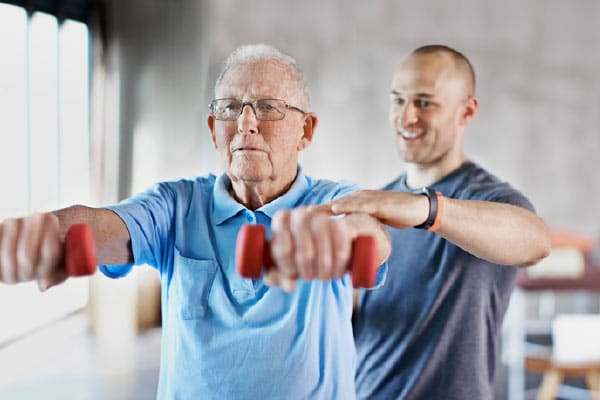“Arthritis” is a catchall term frequently used as an informal way to refer to joint pain, swelling, stiffness, and decreased range of motion that can become prevalent as people age. While osteoarthritis and rheumatoid arthritis are two of the more common forms of the disease, there are in fact more than 100 types of arthritis and related conditions.
In the United States, approximately 1 in 4 adults have arthritis. Arthritis can be caused by age, overuse and wear and tear on a particular joint, injuries, obesity, genes, autoimmune disorders, muscle weakness, and more. To better understand how to live with and manage two of the more common forms of arthritis, the aging care experts at American, Advocate and Whitsyms In-Home Care share details about rheumatoid arthritis and osteoarthritis.
Understanding Rheumatoid Arthritis and Osteoarthritis
Symptoms of arthritis typically develop over a period of time, but they can also appear suddenly. Osteoarthritis usually develops after the age of 50 and rheumatoid arthritis usually develops between the ages of 30 – 50 years old. Symptoms are frequently most acute after a person has been resting, sleeping, or sitting idly for an extended period of time.
Rheumatoid Arthritis (RA) is an autoimmune or inflammatory disease where a person’s immune system attacks healthy cells by mistake, resulting in painful inflammation in affected parts of the body. RA usually impacts joints, causing the lining of the joint to become inflamed and in some cases damaged. When joint tissue is damaged, it can result in chronic pain, unsteadiness, and joint misshapenness. RA can also impact other tissues in a person’s body, causing problems in the heart, lungs, or eyes.
Symptoms of RA include:
- Pain or stiffness in more than one joint
- The same symptoms on both sides of the body (for example, both knees)
- Onset in smaller joints such as the hands or feet
- Weight loss
- Fatigue or tiredness
- Fever
- Weakness
- Inflammation of blood vessels and/or the heart muscle
Osteoarthritis (OA) is the most common type of arthritis and occurs when the cartilage in a joint begins to break down and the underlying bone begins to change. OA usually develops slowly and gradually becomes worse over time.
Symptoms of OA include:
- Pain or aching
- Limited range of motion or flexibility that may go away after movement
- Stiffness or swelling
- Muscle weakness around a joint
- Clicking or popping noises when bending a joint
- Joint instability
Treatment for Rheumatoid Arthritis and Osteoarthritis
The goal of any treatment plan for RA or OA is to reduce pain and inflammation and to prevent additional joint damage. To accomplish this, an older adult’s physician will determine the best course of action which may include both medical intervention strategies as well as lifestyle changes such as:
- Exercise. While it may seem counterintuitive to move joints that hurt, incorporating joint-friendly physical activity into a person’s weekly routine can help decrease arthritis-related pain while increasing function, mood, and quality of life. Aim for approximately 30 minutes of low-impact activity each day, such as walking, riding a bike, or swimming.
- Physical and Occupational Therapy. The goal of physical therapy (PT) and occupational therapy (OT) is to make daily activities easier and less painful. Both PT and OT can help increase range of motion and fine motor skills, build strength, and increase balance so that older adults can continue to live active and independent lives.
- Healthy Diet. Eating a well-rounded, low-fat diet that is high in lean protein and fresh fruits and vegetables provides a variety of benefits, including reducing inflammation. Foods like tomatoes, strawberries, blueberries, almonds, olive oil, leafy greens, and salmon have been shown to have anti-inflammatory properties that can benefit individuals with arthritis.
- Weight Loss. Added weight can make joints more painful. Incorporating regular exercise and eating a well-balanced, healthy diet, as well as making other healthy lifestyle choices can help keep weight in a range that reduces the stress on painful joints.
- Medications. A number of over-the-counter and prescription medications are available that can help reduce pain and inflammation associated with RA and OA. Options include NSAIDs, acetaminophen, menthol, or capsaicin creams that block the transmission of pain signals from joints, steroids and immunosuppressants.
- Assistive and Mobility Devices. Assistive devices include a broad range of tools such as extended-handle tools that can help people pick items up off the floor, lever handles instead of traditional round doorknobs, zipper pulls, long-handled shoehorns, a bath stool, and more. Additionally, mobility devices such as a cane, walker, knee brace or shoe inserts can also help reduce pain, while allowing people to remain active.
If an older adult you love is impacted by arthritis, let the referred care providers at American, Advocate and Whitsyms In-Home Care help. With customized care plans developed to meet the unique needs of each individual we care for, the professional care providers we refer can help encourage regular exercise, plan and prepare healthy and nourishing meals, provide medication reminders and transportation to physical therapy or doctor’s appointments, and much more.
Reach out to us any time to learn more about our wide variety of in-home care services that help older adults throughout Florida remain independent and active by clicking on the link to the location nearest you:
- American In-Home Care – Serving North, Central, and West Coast of Florida
- Advocate In-Home Care – Serving Southeast and Southwest Florida
- Whitsyms In-Home Care – Serving Southeast and Southwest Florida
State of Florida License and Registration Numbers: 30211518, 30211651, 30211295, 30211390, 30210978, 30211293, 30211382, 30211504, 30211733, 30211535, 30211531, 30211710, 30211709, 30211045, 5661


